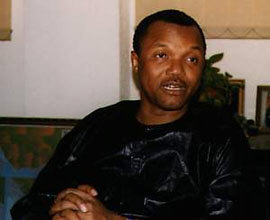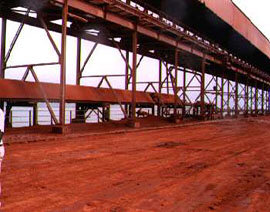 MINERAL RESOURCES MINERAL RESOURCES
 SITTING ON A MINERAL FORTUNE SITTING ON A MINERAL FORTUNE
Guinea is an extremely rich country in terms of mineral resources: gold, diamonds, bauxite, iron and granite abound. There are other mineral reserves still not exploited industrially such as platinum, copper, chrome, cobalt, uranium, lead, titanium, chalk, etc. On top of all this, the existence of important oil and gas reserves have been confirmed. Mining and energy represent 25% of GDP. But it is mining (18.6% of GDP) that has traditionally pulled its main source of foreign currency and tax revenues from the Guinean economy. However these sectors have undergone serious restructuring. Today their growth rate is 4%. The government has fixed their growth at 8-9% by the year 2010. For that, foreign investment is needed.
 MINING SECTOR CARRIES THE BURDEN OF THE ECONOMY MINING SECTOR CARRIES THE BURDEN OF THE ECONOMY

In the past minerals accounted for 90% of exports. Today Guinea’s foreign trade still relies heavily on the mining sector (82% of exports in 1996). Despite its plentiful natural resources Guinea has not been able to convert them. For almost 40 years the transformation process of bauxite into aluminum has been executed abroad, depriving Guinea of substantial dividends. The minister of natural resources and energy, Mr. Fassiné Fofana , believes that the only way for Guinea to stop being so dependant on bauxite is to diversify production. For this reason, a new mining code offering attractive incentives to investors was introduced in 1995, and the Centre de Promotion et Développement Minier offers assistance to investors interested in setting up operations in Guinea. Today international mining companies have gotten established in Guinea, allowing a diversification of the sector.
 FOREIGN COMPANIES COPE WITH GOLD MARKET FOREIGN COMPANIES COPE WITH GOLD MARKET
Guinea’s gold has been known since the times of Herodotus. In the Middle Ages, Arab historians recorded emperor Mansa Moussa’s trip to Mecca with 100 camels carrying large quantities of West African gold. Since old times, extraction has traditionally been artisanal. Since multinational companies have started to settle down in Guinea, gold production methods have quickly changed.
SAG (Société Aurififère de Guinée) restarted mining after its closing down in 1992 due to financial problems. Ashanti Goldfields , the Ghanaian gold company has recently started operations. The Societé Minière de Dinguiraye (SMD), extracted 1,5 tons of 95% purity gold in 1997, and it will surely reach 2 tons by the end of 1998. These figures, might not be impressive at first, but it should be known that SMD only obtained its first lingot in 1995 after 6 prospecting campaigns.
|

The director general of SMD, Mr. Daniel Larribe, explains that the key to their success has been finding the precious mineral not out of traditional quartz deposits, but rather in rock deposits where gold was not easily seen. Prospecting has been carried out with their own funds, unlike Ashanti, who had to endebt itself to do so. Shareholders - 85% of the capital is owned by Norwegian company Kenor and 15% by the State - have taken the risk of supporting the burden of investments, but now all these efforts are starting to yield dividends (1996 production was worth US$14.5 million).
Mr. Larribe, a shy man with gentle manners, points out that their production objective for the year 2000 is 5 tons per year. Therefore SMD priority is to find new gold beds. This year they have already started prospecting new sites. SMD has already identified gold rich gravels in ancient river beds containing proven reserves of 100,000 ounces.
SMD is a socially conscious company. Aware of the needs of its workers, the gold company has created a school, a literacy center, a health center, and provides microcredits for farmers. In this way, prosperity is ensured not only for the region, but also for SMD.
 DIAMONDS ARE FOREVER... DIAMONDS ARE FOREVER...
Extraction of diamonds remains mainly artisanal. In an effort to attract foreign investors the government prohibited this activity to individuals, but was forced to allow it again in 1992. Today it is not unusual to be approached in the street by someone carrying diamonds wrapped in a piece of dirty paper. Only 15% of total exports are officially declared. Diamond deposits are still quite large and the government has managed to attract multinational companies such South African De Beers. Pakistani-Canadian Aredor started production in 1985 being forced to stop operations in 1994 due to clashes with workers. They resumed operations in 1996 striking an extremely good-quality diamond vein (their 1998 average price per carat was US$603).
Lion Star’s director general, Mr. Vartan Somoundjian, behaves like a movie star. Everyone knows him. This seems to be the key to his company's success in Guinea. Lion Star, an Armenian diamond bureau, purchases diamonds from locals. Tight security measures keep the precious stones safe while a team of experts scrutinize size, quality, color and shine of the gems. Once a price has been settled, the stones will be sent to be cut to Lion Star's head office in Antwerp (Belgium). Many of the best diamond veins are exploited at a very small scale by illiterate workers. Medium size enterprises like that of Mr. Somoundjian, permit small local producers to sell their production at reasonable prices. |

